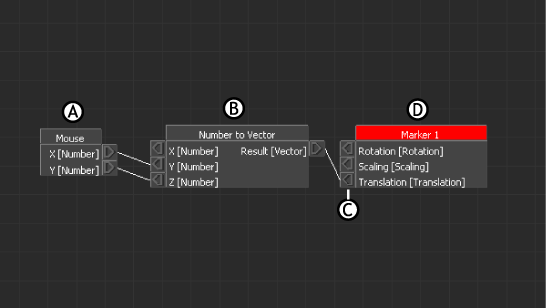The objects used to create a Relations constraint can be broken down into three types:
A Sender can be an input device or a model. Senders are used to transmit data to operations and Receivers. Senders only send data.
In the following figure, “A” is the mouse Sender, which means that the data used in the constraint is created by the mouse’s X and Y position.

Relations constraint A. Sender B. Operator C. Connector D. Receiver
An Operator is an object that performs mathematical operations, comparisons, or conversions. It is placed between a Sender and a Receiver. Operators receive and send data.
In the previous figure, the Operator, “B”, takes the mouse’s Y and Z data and interprets the result into vector information to be read by the marker.
A Receiver can be a model or an output device. Receivers receive data transmitted from Operators and Senders. In the previous figure, “D” is the Receiver, in this case a Marker, which moves according to the mouse’s (Sender) position, which is modified by the Operator.
 Except where otherwise noted, this work is licensed under a Creative Commons Attribution-NonCommercial-ShareAlike 3.0 Unported License
Except where otherwise noted, this work is licensed under a Creative Commons Attribution-NonCommercial-ShareAlike 3.0 Unported License